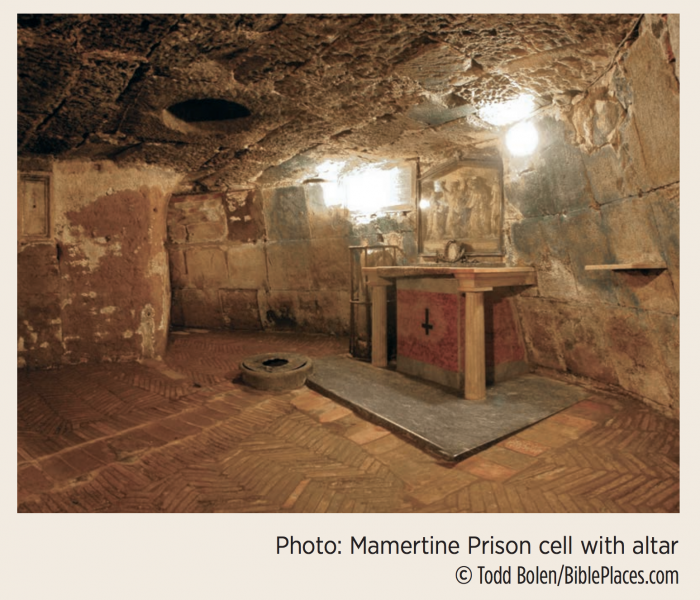In the New Testament, we hear a lot about Christians being imprisoned—especially Paul. In fact, he wrote his letter to the Philippians while in a Roman prison! We’ve gathered information from the ESV Archaeology Study Bible for you to learn more about Roman jails were like.
PAUL WRITING THE PHILIPPIANS FROM PRISON
In the Roman world, imprisonment was rarely a long-term punishment. Most prisoners were awaiting either trial or execution. Debtors could be imprisoned until their friends or family paid o‘ the debt (Matt. 18:30). The length of imprisonment depended on the swiftness of a trial, which could be drawn out for years, especially in political cases. Conditions of imprisonment were closely linked to the status of the prisoner. Non-Roman citizens, even of high status, were often harshly treated. In contrast, house arrest was typically more comfortable for the prisoner, who was usually physically chained to a guard but could still host visitors.
ROMAN PRISON CONDITIONS
Paul experienced a wide variety of Roman prison conditions. He was chained in a common holding cell in Philippi (Acts 16:23– 30), imprisoned in probably better conditions in the praetorium at Caesarea (Acts 23:35), and held in relative comfort while in house arrest in Rome (Acts 28:16). In Rome, Paul was responsible for maintaining himself during his imprisonment, including his meals and clothes (Acts 28:30). Paul’s Roman citizenship meant he was eligible for a daily food allowance, but Paul depended on his friends and fellow believers to supply this food. While under house arrest in Rome, Paul was guarded around the clock by soldiers of the elite Praetorian Guard.
AFTER PAUL WROTE PHILIPPIANS
Finally, when he was later rearrested and executed (likely a few years after this letter), Paul was probably placed in an underground cell somewhere in Rome. It is possible that he was then imprisoned in the Roman Mamertine Prison in the Roman Forum. This was where major convicted enemies of the state were strangled or kept before being thrown off the Tarpeian Rock on the Capitoline Hill. However, if Paul was executed by a sword outside the city, as later tradition claimed, he probably would not have been imprisoned at Mamertine.
MORE INFORMATION ON THE BOOK OF PHILIPPIANS
AUTHOR
Paul is the stated author of Philippians, and while Timothy is listed in 1:1 as a coauthor, the main voice is clearly Paul’s. Timothy may have been Paul’s amanuensis, or secretary. The letter was written to the Christians in the Roman colony of Philippi. Some scholars have suggested that the current epistle combines two authentic letters of Paul, with the first letter concluding at 3:1 (“Finally, my brothers . . .”). However, Paul elsewhere uses “finally” in the middle of an epistle (1 Thess. 4:1; 2 Thess. 3:1; cf. 1 Pet. 3:8).
DATE
Paul wrote this letter while in a Roman prison, and the date of the composition of Philippians depends on where Paul was imprisoned. His statements to the Philippians concerning his possibly imminent death (e.g., Phil. 1:20) indicate the letter was most likely written from Rome, perhaps in AD 62. This also fits most naturally with the mention of the praetorium and “Caesar’s household”.
BACKGROUND
The church at Philippi had a special significance for Paul, as it was the first church he founded in Europe (see Acts 16:6–40). The first convert was Lydia, a seller of purple cloth, and women continued to have a prominent role in the Philippian church (e.g., Phil. 4:2). His brief incarceration in Philippi (Acts 16:23–40) would make Paul’s later imprisonment mentioned in this letter all the more poignant for the Philippians, especially for the converted Philippian jailer. Paul visited Philippi a few times after his initial departure, and the church maintained active support for his ministry (Phil. 4:15–16). Imprisonment carried with it a social stigma, and it would have been easy for the Philippians to turn their back on Paul at this point; instead, however, they remained faithful to him. Paul thus writes of his gratitude for the Philippian church and for their loyalty to the gospel.
ESV ARCHAEOLOGY STUDY BIBLE
This blog is adapted from notes inside the ESV Archaeology Study Bible. This resource roots the biblical text in its historical and cultural context. Then it offers readers a framework for better understanding the people, places, and events recorded in Scripture. With this knowledge, Christians will be better equipped to read, study, understand, and apply the Bible in their daily lives.





0 Comments